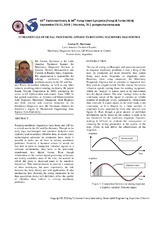| dc.description.abstract | Rotating machinery diagnostics have been, and will be, a critical area in the Oil and Gas Industry. Though in the early days oscilloscopes and spectrum analyzers were typically used to analyze vibration data, in recent years, technological advances in computers have made it possible to make use of them in solving machinery problems. However, it becomes critical to accept the fact that in order to manipulate vibration signals in a software environment, they have to be previously transformed into digital format. Even though information on the various signal processing techniques are readily available, most of the time, the manner in which this topic is discussed tends to be somehow theoretical. This tutorial intends to provide a summary of these techniques, but most importantly, the link between the basic theory and real applications. It also emphasizes how choosing the wrong parameters in the data acquisition device will definitely affect the quality of vibration data, critical to solving machinery problems. | en |


